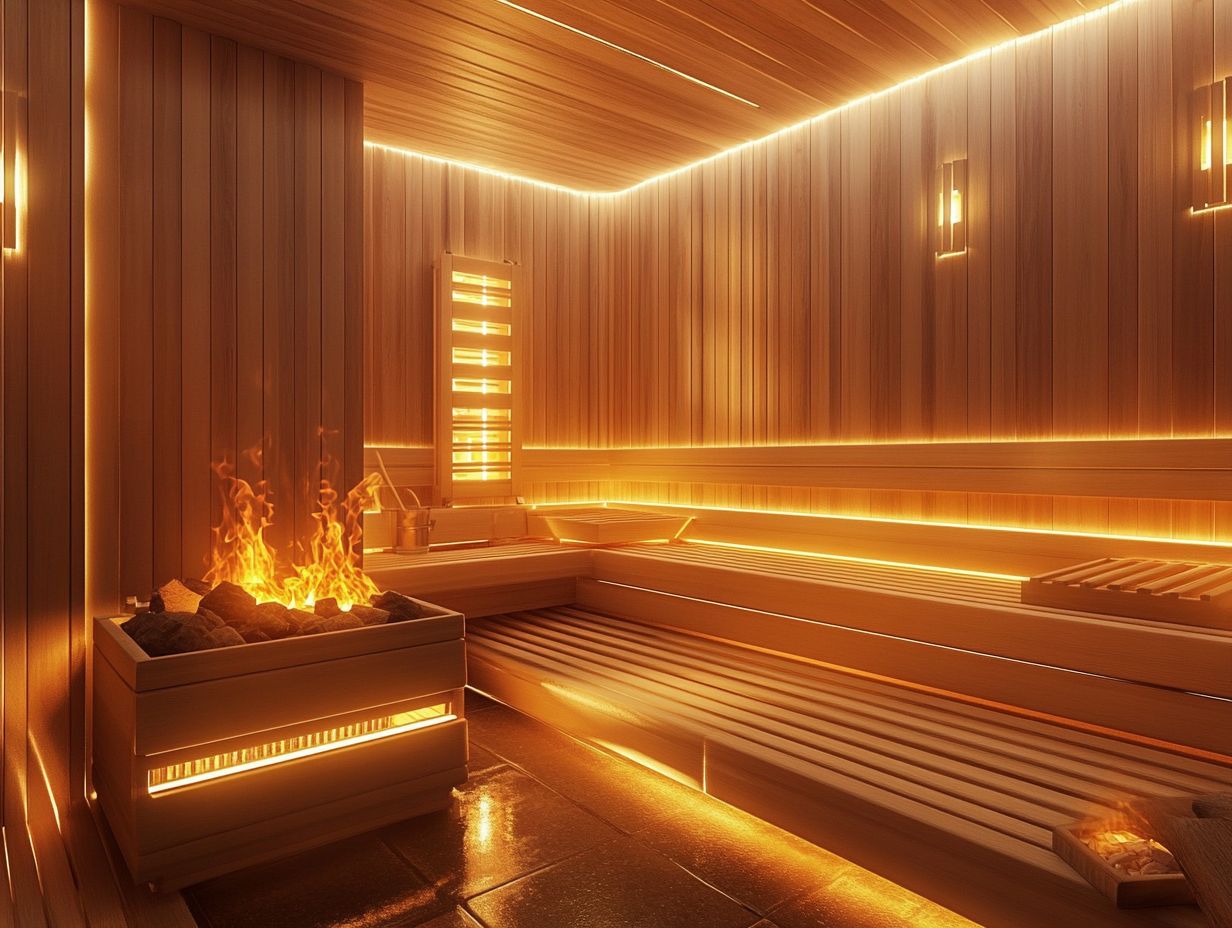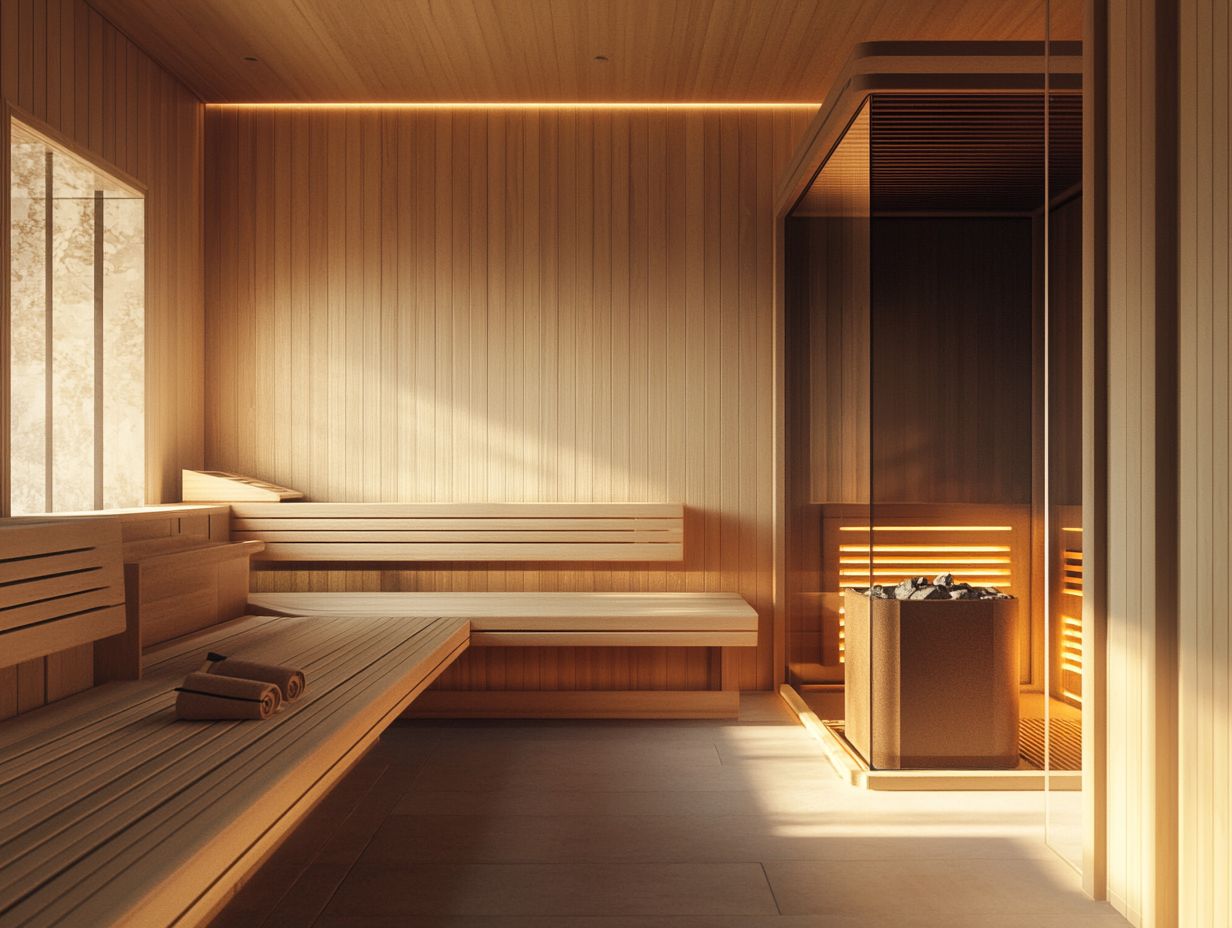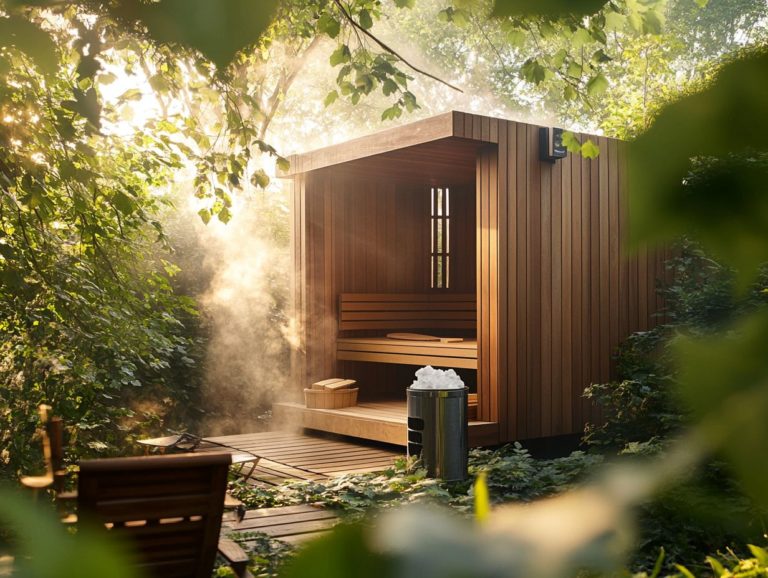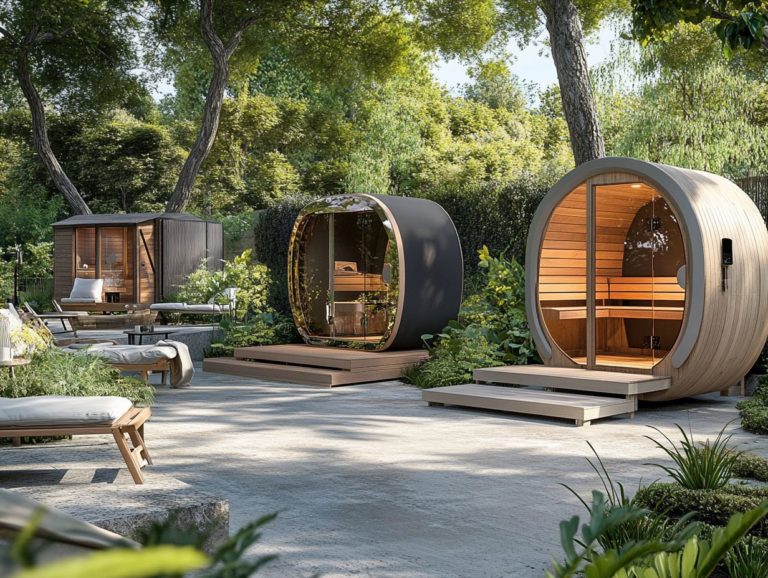Exploring Different Sauna Heating Methods
Saunas have long been revered for their soothing and therapeutic benefits. However, not all saunas deliver the same experience.
By grasping the various heating methods from traditional wood-burning stoves to cutting-edge infrared heaters you can elevate your sauna journey.
This article explores the nuances of different heating techniques, assessing their efficiency, costs, and distinct advantages. Whether you’re contemplating the installation of a sauna or simply exploring the options at your disposal, you’ll uncover insights that empower you to make the most informed choice for your needs.
Contents
- Key Takeaways:
- Traditional Sauna Heating Methods
- Modern Sauna Heating Methods
- Comparing the Different Sauna Heating Methods
- Choosing the Right Sauna Heating Method for You
- Frequently Asked Questions
- What are the different methods of heating a sauna?
- What are the benefits of each heating method?
- Which sauna style suits your lifestyle best?
- Which sauna heating method is the most popular?
- How do I know which sauna heating method is right for me?
- Are there any safety concerns with sauna heating methods?
- How do I maintain my sauna’s heating method?
Key Takeaways:

- Traditional sauna heating methods, such as wood-burning stoves and electric heaters, have been used for centuries and provide a unique and authentic sauna experience.
- Modern sauna heating methods, like infrared heaters and steam rooms, offer a more convenient and efficient sauna experience, with benefits such as easier installation and lower operating costs.
- When choosing the right sauna heating method for you, consider factors such as energy consumption, average cost, and personal preferences to find the perfect fit for your sauna experience.
What is a Sauna and How Does it Work?
A sauna is more than just a small room; it s your gateway to a unique heating experience. Various methods, like electric, gas, or wood-burning stoves, heat the space, creating an inviting and relaxing atmosphere. Sauna enthusiasts rave about the many health benefits, from improved circulation to deep relaxation.
Each type maintains humidity with steam or uses infrared heat. Infrared heat penetrates deep into your body’s tissues, providing a unique experience.
Take traditional Finnish saunas, for example. They combine high temperatures with low humidity to encourage sweating and detoxification. On the other hand, infrared saunas provide a gentler warmth, focusing on specific muscle groups while enhancing energy efficiency.
If you’re pursuing health goals like weight loss, better skin health, or stress relief, you can find sauna experiences tailored to your preferences and needs.
The sauna experience envelops you in tranquility, allowing you to unwind and rejuvenate. It s a cherished ritual in cultures worldwide, inviting you to embrace relaxation and wellness in a truly enriching way.
Traditional Sauna Heating Methods
In terms of traditional sauna heating methods, you have a few notable options: wood-burning stoves, electric heaters, and, to a lesser extent, gas heaters. Each option has unique characteristics that greatly impact your overall experience, heating capacity, and maintenance needs.
The type of heater you choose can profoundly shape the sauna atmosphere. Imagine the deep, aromatic warmth of a wood-fueled fire! You can also experience the effortless convenience of electric heating systems, which offer consistent temperature regulation. This flexibility allows you to cater to your personal preferences and create the perfect sauna environment for relaxation.
Wood-Burning Stoves
Wood-burning stoves are a quintessential choice for traditional saunas, offering an authentic experience defined by rich heat quality and a warm ambiance enhanced by the natural aroma of burning wood. Their capacity to generate distinctive warmth makes them a favorite among sauna enthusiasts who cherish the connection to historical practices and the tranquil atmosphere they foster within the sauna.
Installing these stoves can come with certain challenges. Proper ventilation is crucial to ensure efficient combustion and to prevent the accumulation of harmful gases, which might require modifications to existing structures, including proper heater maintenance.
The energy source depends on the availability and cost of wood, which can vary due to environmental regulations and market fluctuations. While wood-burning stoves provide an unparalleled, cozy heat that many find comforting, it’s essential to consider the drawbacks as well such as the need for regular maintenance and the potential for increased dust and creosote buildup, which could pose safety and health risks if not managed diligently.
Electric Heaters

Electric heaters offer a modern solution for traditional saunas. They provide energy-efficient heating with precise temperature control, allowing you to easily customize your sauna experience. With much shorter preheat times than wood-burning options, these heaters are perfect for those who value convenience without losing the authentic sauna atmosphere.
Beyond their quick heat-up capabilities, electric heaters can save you money in the long run. You can cut down on energy bills while still enjoying maximum comfort. Unlike wood-burning stoves, which require constant buying and storing firewood, electric units eliminate mess and ongoing maintenance.
Equipped with safety features like overheat protection and timers, electric heaters let you relax without worry. This combination of efficiency, safety, and versatility makes electric heaters a smart choice for anyone looking to enhance their home sauna experience.
Modern Sauna Heating Methods
Modern sauna heating methods have evolved significantly. You can now choose from innovative options like infrared saunas and steam rooms. Each offers unique benefits, enhancing your overall sauna experience.
Infrared saunas use thermal energy waves that warm your body directly, providing a soothing effect. On the other hand, steam rooms create a humid environment, which is great for your respiratory health and relaxation.
This variety appeals to many different sauna enthusiasts, each with unique health goals.
Infrared Heaters
Infrared heaters are an important part of infrared saunas. They are known for delivering deep-penetrating heat efficiently, enhancing your wellness journey and promoting various health benefits like improved circulation and detoxification. Unlike traditional heating methods, infrared heaters use a different energy source, making them an attractive choice for those focused on maximizing their health.
These modern tools use infrared radiation, a type of energy that heats the body directly instead of the surrounding air. This allows for quicker heating and a more comfortable environment, even at lower temperatures. Not only does this method save energy, but it also improves your sauna experience, letting you enjoy relaxation without extreme heat.
You ll find the gentle warmth inviting, promoting muscle relaxation and stress relief, creating a calm space to unwind. With their user-friendly features and energy efficiency, infrared heaters meet the needs of modern wellness enthusiasts like you, who seek holistic benefits.
Steam Rooms
Steam rooms offer a refined alternative to traditional saunas. They surround you with high humidity levels, creating an unmatched atmosphere for relaxation and health benefits. This inviting space attracts sauna enthusiasts seeking a unique experience. The moist heat softens your skin, improves respiratory health, and fosters tranquility, making steam rooms an exciting choice for those on a wellness journey.
Unlike dry saunas, steam rooms work at lower temperatures yet still provide therapeutic effects through moisture. This humid atmosphere encourages a healthy sweat, aiding detoxification and boosting circulation, which can alleviate muscle tension and joint discomfort.
The steam also helps those with respiratory issues by clearing nasal passages and making breathing easier. If you want to accelerate post-workout recovery or improve your skin’s appearance, steam rooms offer a refreshing option that complements your traditional sauna sessions.
Comparing the Different Sauna Heating Methods

When you compare various sauna heating methods, it s exciting to discover factors like efficiency, cost, and the specific health benefits each option offers. This careful evaluation empowers you to make a well-informed decision that aligns perfectly with your personal preferences and health goals.
From the timeless charm of traditional wood-burning stoves to the cutting-edge technology of modern infrared heaters, understanding the unique advantages of each method helps you choose the ideal fit for your sauna experience.
Efficiency, Cost, and Benefits
Evaluating the efficiency, cost, and benefits of various sauna types is essential for enhancing your sauna experience while aligning with your personal health goals. This involves carefully considering factors such as heating elements, installation requirements, and ongoing maintenance costs associated with different heater types.
Examine energy consumption patterns and insulation quality, as these significantly affect your long-term operating expenses. Each sauna type be it traditional wood-fired, infrared, or steam offers unique advantages tailored to diverse preferences. Traditional saunas provide an authentic experience with holistic benefits, while infrared options are celebrated for their low energy consumption and faster heating times.
Additionally, considering the lifespan and durability of the materials used in construction can influence your choices, ensuring that the sauna you select contributes positively to both your physical health and overall well-being.
Choosing the Right Sauna Heating Method for You
Selecting the ideal sauna heating method tailored to your needs requires thoughtful consideration of your personal preferences, how much space you have, and the distinct health benefits each option presents.
Whether you favor the authenticity of a traditional wood-burning sauna or the efficiency of an infrared heater, understanding these elements will elevate your overall sauna experience and enrich your wellness journey. Don t miss out on the benefits of regular sauna use!
Factors to Consider
Diving into the sauna selection process is exciting! Consider your personal preferences regarding heating methods, maintenance requirements, and installation specifics. These elements can significantly impact your overall satisfaction and the health benefits you reap from regular sauna use.
The decision between infrared and traditional steam heating can dramatically influence the warmth level, comfort, and the therapeutic effects you experience. The materials used in construction are equally important, affecting both durability and safety. Additionally, the ease of maintenance can dictate how often you engage with your sauna.
Don t overlook the installation specifics, such as size and location within your home; these factors are vital for accessibility and routine use. By understanding these dynamics, you can make informed choices tailored to your lifestyle, ensuring that each sauna session enhances your well-being.
Frequently Asked Questions

What are the different methods of heating a sauna?
There are three main methods of heating a sauna: traditional, electric, and infrared. Traditional saunas use heated rocks and water to create steam, while electric saunas use heating elements to warm the air. Infrared saunas warm your body directly without heating the air, offering a different type of experience.
What are the benefits of each heating method?
Traditional saunas are known for their relaxation and detoxification benefits, while electric saunas are more energy-efficient and easier to control the temperature. Infrared saunas offer similar benefits as traditional saunas, but with lower temperatures and less humidity.
Which sauna style suits your lifestyle best?
Consider your preferences, space, and health goals when choosing a sauna style. Each option presents unique advantages that can enhance your well-being.
Which sauna heating method is the most popular?
Electric saunas are the most popular option because they’re convenient and easy to use. They’re also more budget-friendly than traditional saunas, which need regular maintenance and replacement of heated rocks.
How do I know which sauna heating method is right for me?
It really depends on your preferences and needs. If you love the classic sauna experience with its high heat and humidity, a traditional sauna is perfect for you!
If you’re looking for a more convenient option that saves energy, electric or infrared saunas might be a better fit.
Are there any safety concerns with sauna heating methods?
Every sauna heating method has safety considerations. Traditional saunas need regular maintenance to prevent overheating and potential fire hazards. Electric saunas need proper installation to avoid electrical issues. Infrared saunas, which use light to create heat, may not be suitable for everyone, so consult with a doctor before use.
How do I maintain my sauna’s heating method?
Maintenance varies for each sauna heating method. For traditional saunas, regularly clean the rocks and replace them when needed. Electric saunas should be checked for electrical issues and cleaned regularly.
Infrared saunas typically require minimal maintenance, but be sure to follow the manufacturer’s instructions for cleaning and upkeep. Don’t wait to check your sauna safety first!






